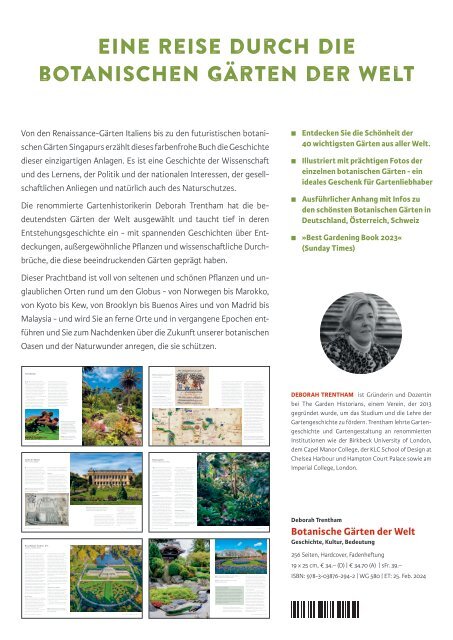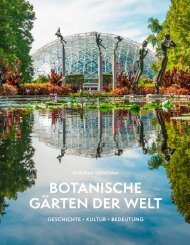Midas Collection F24
Sie wollen auch ein ePaper? Erhöhen Sie die Reichweite Ihrer Titel.
YUMPU macht aus Druck-PDFs automatisch weboptimierte ePaper, die Google liebt.
collides with cutting-edge scientific<br />
developments. Throughout history the<br />
role of botanic gardens has shifted<br />
according to the context of the time, from<br />
primarily places of medical research to<br />
key theatres in the age of exploration,<br />
and more recently with a focus on<br />
conservation in the face of the escalating<br />
climate challenges.<br />
With their earliest origins stretching<br />
back to the ancient Levant, it is said<br />
that there are currently over 2,500<br />
botanic gardens in existence around<br />
the world. Today, they are forging<br />
the way in conservation efforts and<br />
6 | b o ta n i c g a r d e n s o f t h e world<br />
scientific research, but the roots of<br />
these horticultural institutions are much<br />
older. From early blueprints such as the<br />
4th century BC garden of Aristotle, or<br />
the oldest botanic gardens that have<br />
been in continual use – the Garden of<br />
the University of Padua, established in<br />
1545. In this book we explore the history<br />
of botanic gardens through 40 examples<br />
of the most important and fascinating<br />
gardens of the world. Beginning with the<br />
earliest examples, exploring the early<br />
origins of botanic gardens in Renaissance<br />
Italy at Pisa and Padua, then moving<br />
through the centuries to the present day<br />
and discovering how the creation and<br />
purpose of botanic gardens has evolved<br />
throughout history.<br />
with eleven gardens, so devoting a sunny<br />
day to it with a picnic and a map is the<br />
best way to discover its many pleasures.<br />
including a labyrinth, a zoo, museums and<br />
stunning Art Deco glasshouses. Located History<br />
on the left bank of the Seine, in the 5th The idea for the Jardin des Plantes<br />
arrondissement of Paris, it covers 28 originated with King Louis XIII, who<br />
hectares (69.1 acres) and contains around instructed his physician Jean Hérouard<br />
10,000 species and varieties of plants, to create a medicinal garden for him.<br />
2,000 trees, and 2,500 shrubs: its<br />
Hérouard had seen the first-ever botanic<br />
grounds have 80,000 seasonal plants, garden in France, opened in the southern<br />
and burst with colour. This is a large site city of Montpellier on the orders of<br />
Henri IV in 1593. It was attached to a<br />
medical school, taught medicinal plant<br />
below: 1636 plan of Paris’s ‘Jardin du Roy for the knowledge, and became the prototype for<br />
cultivation of medicinal plants’ by Guy de La all subsequent French botanic gardens.<br />
Brosse and Frédéric Scalberge.<br />
Hérouard wanted to create something<br />
left: Mosaïcultures Internationales.<br />
In 2013 the competition took place<br />
in Montréal Botanic Gardens.<br />
Mosaïculture is the art of making<br />
three-dimensional sculptures from<br />
plants and flowers, here over three<br />
million flowers were used to produce<br />
sculptures which were then displayed<br />
in the garden.<br />
opposite: The sub-tropical gardens<br />
at Tresco Abbey on the Isles of Scilly<br />
have their own microclimate.<br />
above: Behind the green lawns or the boulingrins is the<br />
controversial move, as the south of the<br />
Grand Gallery of Evolution which holds the historical<br />
country was politically at odds with the<br />
zoology collections. It originally opened in 1889.<br />
north at the time.<br />
The establishment of the Garden<br />
brought plant hunting and collecting<br />
similar in Paris, and in 1626, Guy de La under the control of the King, who<br />
Brosse was made the new Garden’s<br />
instructed the French navy to amass<br />
intendant. He quickly started to acquire exotic specimens from around the<br />
seeds and plants from around the world, globe. In 1636, La Brosse published his<br />
and after Hérouard’s death, it was left to Description du Jardin royal des Plantes<br />
him to present the King with a plan for the médicinales, listing 1,800 species and<br />
garden in April 1634. Staff were brought varieties then being cultivated in the<br />
from Montpellier to help develop it – a Garden.<br />
48 | b o ta n i c g a r d e n s o f t h e world j a r d i n d e s pl a n t e s | 49<br />
to England aged 17 for her arranged<br />
marriage to Frederick, Prince of Wales,<br />
that was to change the landscape.<br />
(300-acre) site on the edge of London, Frederick took a lease on the Kew estate,<br />
home to the world’s biggest collection and both he and Augusta became<br />
of living plants and more than 8.5 million involved with reshaping it. Frederick<br />
preserved plant and fungal specimens. It began a collection of exotic plants, and<br />
is a setting rich in history that spans from after his sudden death in 1751, the now<br />
royal follies to colonial exploitation and Dowager Princess of Wales Augusta<br />
wartime bombing. Kew states its mission created a 3.6-hectare (9-acre) botanical<br />
is to ‘protect plants and fungi for the future garden just south of the Orangery. By<br />
of all life on Earth’, and to investigate 1768, it contained 2,700 species, and<br />
the plant world for new sources of food, botanist and gardener Thomas Knowlton<br />
medicine, fuel and materials.<br />
said that the Princess’s gardens had one<br />
Kew continues to help us understand of the best collections in the kingdom, if<br />
the wonders of nature and to question not the world.<br />
how we care for it in a world where climate As a reminder of Augusta’s garden, an<br />
is now dangerously being ignored.<br />
area of Kew is reserved for a collection<br />
Installations like The Hive whirring away planted out in strict Linnaean order and<br />
in the middle of a wildflower meadow, with each plant labelled. The Princess of<br />
recreating life inside a beehive, remind us Wales Conservatory is also named for<br />
of the challenges bees face to survive and her.<br />
the landscape they and we need to thrive.<br />
Designed by artist Wolfgang Buttress, 18th-Century Follies<br />
it features a thousand LEDs lighting up Augusta commissioned various buildings<br />
according to the vibrations of bees, and and follies from architect Sir William<br />
creates a musical symphony in the key of Chambers, including the Pagoda, the<br />
C – the same key as bees buzz in!<br />
Orangery and the Ruined Arch (all<br />
survive), and the Great Stove, the Temple<br />
The History<br />
of the Sun and the Mosque (not extant).<br />
Grade I-listed Kew Palace, the smallest of A recent restoration of the Ruined Arch<br />
all the British royal palaces, was originally revealed that it contains pieces of Greek<br />
built for a silk merchant in 1631. In the and Roman sculpture.<br />
1720s George II and Queen Caroline<br />
George III, who reigned from 1760,<br />
arrived with their three eldest daughters, inherited both the Richmond and Kew<br />
to use Kew and nearby Richmond Lodge<br />
as weekend retreats, enjoying some<br />
privacy away from Court life.<br />
right: An autumnal aerial view of the Royal<br />
It was the arrival, in 1736, of Princess Botanic Gardens at Kew, London, showing the<br />
Augusta of Saxe-Gotha, who came<br />
Palm House and lake.<br />
120 | b o ta n i c g a r d e n s o f t h e world r o ya l b o ta n i c g a r d e n s , k e w | 121<br />
right: A beautifully illustrated folio from an Arabic<br />
translation of Dioscorides’ De Materia Medica,<br />
possibly from Baghdad.<br />
herbal texts as inaccuracy could be<br />
dangerous. He wasn’t wrong to be wary,<br />
Theophrastus was a philosopher and<br />
botanist, Dioscorides was a physician,<br />
pharmacologist and botanist but not<br />
all the early authors came with this<br />
background. Other writers were not<br />
botanists and were unfamiliar with many<br />
of the plants they were documenting.<br />
The Age of Discovery<br />
Important factors that impacted plant<br />
movement across the globe included,<br />
from the 14th century onwards,<br />
Portuguese sailors and their voyages of<br />
discovery, followed swiftly by the Spanish<br />
and other Europeans. Although it was the<br />
later 15th century Portuguese discoverers However the botanic gardens as<br />
who filled the royal courts in Lisbon with we know them today began in the<br />
gold, spices, illuminated manuscripts, 16th century in Italy with the advent of<br />
talking birds, exotic animals and plants. iatrochemistry. The Italian Renaissance<br />
The gardens and menageries were lost saw the medicinal simples gardens of the<br />
in the Lisbon earthquake and tsunami monasteries evolve into physic gardens,<br />
of 1755, as was the royal library with its these were attached to centres of learning<br />
manuscripts and its attached Cabinet of and were the forerunners of today’s<br />
Natural History. In 1453, two major world botanic gardens. The gardens of Pisa and<br />
events happened: one was the invention Padua were the first to be founded for<br />
of the printing press, and Pliny’s Historia the academic study of medicinal plants,<br />
Naturalis was published in Venice in 1469. Universities across Europe were quick<br />
The other event was when the Ottoman to follow and gardens such as Leiden<br />
army captured Constantinople, one<br />
and Oxford were founded. They were<br />
outcome of this was the circulation of still using the ancient texts, including<br />
Greek scientific treatises and texts into those of Theophrastus and Dioscorides,<br />
western Europe.<br />
while at the same time new plants were<br />
being brought into Europe from other<br />
continents, Africa and the Americas,<br />
these were plants which people were<br />
not sure how to use, whether they were<br />
medicinal or culinary. The rich trading<br />
ports of Venice and the Amalfi coast<br />
brought not only spices and treasures<br />
into Italy but also these exotic and<br />
unknown plants. New classifications and<br />
investigations were needed to understand<br />
how the plants could be utilized.<br />
Some of these new and exotic finds<br />
were going into the hands of private<br />
collectors, the Renaissance Humanist<br />
garden makers inspired by classical<br />
literature, such as Homer (who mentions<br />
hundreds of different plants) and the<br />
gardens described in the letters of Pliny<br />
in Britain at the time – a glasshouse filled<br />
with foreign plants, suitable for concerts,<br />
dancing and taking tea.<br />
and its importance for the community. A In May 1868 a committee was formed<br />
botanical haven located in the centre of to help fund the Biebricher Wintergärten,<br />
Frankfurt, it houses plants from all over and when shares were issued, they<br />
the world as a source of education and proved so popular that the committee<br />
an oasis of calm within the city. It also was able to buy the Duke’s valuable<br />
provides a stunning setting for regular plant collection. The City of Frankfurt<br />
music performances and concerts.<br />
gave about 7 hectares (18 acres) of<br />
The Garden’s displays and collections land to them, and, under Siesmayer’s<br />
now hold more than 13,000 subtropical supervision, the glasshouses were<br />
and tropical species, cultivated in themed erected by 1869, and hosted their first<br />
gardens and arranged according to<br />
flower show in 1870. The ‘Palm Garden’<br />
plant types in the greenhouses (7,000 is now one of the largest of its kind in<br />
sq.m/75,347 sq.ft) and the landscape Europe, and still functions in the ‘Winter<br />
grounds which stretch over 22 hectares Garden’ tradition, holding concerts and<br />
(54 acres).<br />
functions.<br />
Siesmayer was director from<br />
The History<br />
1868 to 1886, and was succeeded by<br />
The first botanic garden in Frankfurt was August Siebert (1854–1923), a great<br />
founded in 1763 by Dr. Johann Christian horticultural and botanical expert.<br />
Senckenberg as a hortus medicus for his Siebert was to expand and improve<br />
Senckenberg Foundation. It moved twice the site over his forty years in charge,<br />
before being set up on the present site. building new greenhouses and installing<br />
What we know as the Palmengarten electricity. He was also responsible for<br />
was originally established after the<br />
the first published companion to the<br />
1866 Austro-Prussian War, when Duke Palmengarten, which appeared in 1895.<br />
Adolphe of Nassau was exiled from his<br />
estate at Wiesbaden-Biebrich, west of The War periods<br />
Frankfurt. This prompted him to sell his During the First World War, the<br />
exotic and tropical plant collection, with greenhouses and grounds were used<br />
its extensive greenhouses and worldfamous<br />
conservatories. Garden designer hospitals. Although the Garden managed<br />
as vegetable plots to supply military<br />
and botanist Heinrich Siesmayer (1817– to be maintained during the war, the<br />
1900) was commissioned by the Duke to<br />
liquidate the collection, but Siesmayer<br />
could not resist the opportunity of<br />
right: The Palmengarten allows visitors the chance<br />
creating a garden himself. He wanted to to see and experience a great diversity of plant<br />
make a ‘Winter Garden’ like those popular species from all parts of the world.<br />
78 | b o ta n i c g a r d e n s o f t h e world pa l m e n g a r t e n | 79<br />
above: A spring display of bedding in the William Nesfield<br />
parterre of 1848, in front of the Palm House.<br />
opposite: The Garden of Peace, based on a traditional<br />
Japanese Tea Garden, at Kew.<br />
A Series of Calamities<br />
Undoubtedly the Gardens’ unluckiest (or perhaps<br />
luckiest?) tree is a Pinus nigra, which has twice been<br />
hit by lightning as well as by a small, low-flying aircraft<br />
that crashed in 1928 (a second aircraft crash-landed<br />
in the Gardens ten years later). Other catastrophes<br />
included the burning down of the tea pavilion by<br />
Suffragettes in 1913, and thirty hits by Second World<br />
War bombs. The Gardens once had their own fire<br />
brigade and still have their own police force, one of<br />
the smallest in the world.<br />
estates, joining them together and<br />
creating Kew Gardens (plural for the two<br />
estates). On the advice of Sir Joseph<br />
Banks, to support voyages of discovery<br />
left: The Cantino Planisphere of 1502 shows the<br />
world as known by the Portuguese after their<br />
great explorations at the end of the 15th century.<br />
i n t r o d u c t i o n | 11<br />
to new lands, the King commissioned a<br />
joint Royal Navy/Royal Society scientific<br />
expedition to the South Pacific Ocean.<br />
Lieutenant James Cook was to command<br />
HMS Endeavour, and Banks was to<br />
join the team of botanical explorers on<br />
board. During the voyage (1768–1771), the<br />
botanists collected over 1,000 species<br />
of plants new to science, and the seeds<br />
were sent to Kew.<br />
On Banks’ return to England in July<br />
1771, he became Kew’s first unofficial<br />
director. Under his guidance, it became<br />
a central hub collecting seeds and<br />
specimens, and he built an international<br />
exchange of resources making it one of<br />
the pre-eminent botanical gardens in<br />
the world. Banks was also behind the<br />
practice of sending out plant hunters/<br />
collectors, including Francis Masson,<br />
a Scottish gardener and Kew Gardens’<br />
first official plant hunter – who, in 1772,<br />
visited what is now called the Floral<br />
Region in South Africa, and returned with<br />
thousands of plants.<br />
r o ya l b o ta n i c g a r d e n s , k e w | 123<br />
Eine Reise durch die<br />
botanischen Gärten der Welt<br />
Von den Renaissance-Gärten Italiens bis zu den futuristischen botanischen<br />
Gärten Singapurs erzählt dieses farbenfrohe Buch die Geschichte<br />
dieser einzigartigen Anlagen. Es ist eine Geschichte der Wissenschaft<br />
und des Lernens, der Politik und der nationalen Interessen, der gesellschaftlichen<br />
Anliegen und natürlich auch des Naturschutzes.<br />
Die renommierte Gartenhistorikerin Deborah Trentham hat die bedeutendsten<br />
Gärten der Welt ausgewählt und taucht tief in deren<br />
Entstehungs geschichte ein - mit spannenden Geschichten über Entdeckungen,<br />
außergewöhnliche Pflanzen und wissenschaftliche Durchbrüche,<br />
die diese beeindruckenden Gärten geprägt haben.<br />
n<br />
n<br />
n<br />
Entdecken Sie die Schönheit der<br />
40 wichtigsten Gärten aus aller Welt.<br />
Illustriert mit prächtigen Fotos der<br />
einzelnen botanischen Gärten - ein<br />
ideales Geschenk für Gartenliebhaber<br />
Ausführlicher Anhang mit Infos zu<br />
den schönsten Botanischen Gärten in<br />
Deutschland, Österreich, Schweiz<br />
n »Best Gardening Book 2023«<br />
(Sunday Times)<br />
Dieser Prachtband ist voll von seltenen und schönen Pflanzen und unglaublichen<br />
Orten rund um den Globus - von Norwegen bis Marokko,<br />
von Kyoto bis Kew, von Brooklyn bis Buenos Aires und von Madrid bis<br />
Ma laysia - und wird Sie an ferne Orte und in vergangene Epochen entführen<br />
und Sie zum Nachdenken über die Zukunft unserer botanischen<br />
Oasen und der Naturwunder anregen, die sie schützen.<br />
Introduction<br />
esigned as spaces of study and<br />
Dresearch, botanic gardens are where<br />
the lavish beauty of the natural world<br />
Jardin des Plantes<br />
Paris, France (1635)<br />
he Jardin des Plantes is laid out as<br />
Ta stunning formal axial garden, in<br />
the French manner. It is full of surprises,<br />
Royal Botanic Gardens, Kew<br />
London, England (1840)<br />
he Royal Botanic Gardens in Kew are<br />
Tthought to be the largest botanical<br />
gardens in the world, a 121-hectare<br />
Palmengarten<br />
Frankfurt, Germany (1763)<br />
he motto of the Palmarum hortus is<br />
T‘Plants, Life, Culture’, celebrating<br />
the unique character of this Garden,<br />
DEBORAH TRENTHAM ist Gründerin und Dozentin<br />
bei The Garden Historians, einem Verein, der 2013<br />
gegründet wurde, um das Studium und die Lehre der<br />
Garten geschichte zu fördern. Trentham lehrte Gartengeschichte<br />
und Gartengestaltung an renommierten<br />
Institutionen wie der Birkbeck University of London,<br />
dem Capel Manor College, der KLC School of Design at<br />
Chelsea Harbour und Hampton Court Palace sowie am<br />
Imperial College, London.<br />
Deborah Trentham<br />
Botanische Gärten der Welt<br />
Geschichte, Kultur, Bedeutung<br />
256 Seiten, Hardcover, Fadenheftung<br />
19 x 25 cm, € 34.– (D) | € 34.70 (A) | sFr. 39.–<br />
ISBN: 978-3-03876-294-2 | WG 580 | ET: 25. Feb. 2024
















